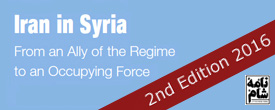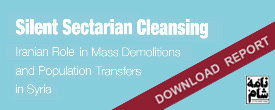After its establishment in 1979, the Islamic Republic of Iran adopted an anti-American foreign policy that led, among other things, to the seizure of the US embassy in Iran and the subsequent US military operation known as the Tabas attack. The Islamic Republic then found itself in a deep crisis with the US and decided to outsource the conflict outside Iran. The country also got involved in a war with Iraq, where the operations inside Iraq were carried out by a special unit of the Iranian Revolutionary Guards known as Sepah Qods. Following consultations with Ayatollah Khomeini, some of the forces of Sepah Qods were sent to Lebanon during the country’s civil war. These undertook training of Lebanese militants, which were later to transform into the military arm of Hezbollah Lebanon.[1]
Since then, Sepah Qods has been active in Lebanon, Afghanistan, Iraq and many other countries. The extent of the force’s presence in Syria and support for Bashar al-Assad’s regime in its recent war against the Syrian population were revealed by footage founded by anti-regime fighters on the camera of a Sepah member who was killed in battle. The footage was handed to the media and formed the basis of a disturbing BBC documentary.[2]
Since then, several other members of Sepah Qods have been killed in Syria and had official funerals organised for them in Iran. Iranian media describe them as ‘martyrs’.[3]
The leader of Sepah Qods is Qasem Soleimani, an Iranian general close to Ayatollah Khamenei. He has been described as one of the most powerful people in the Middle East, with influence reaching beyond Iran and a de facto ruling power in countries like Iraq and Syria.[4]
NOTES:
[1] BBC, ‘Iran and the West’, Part 2 of 3: ‘The Man who Changed the World’, available: http://www.youtube.com/watch?v=91xuueQ7RmI.[2] Available: http://www.youtube.com/watch?v=ZI_88ChjQtU
[3] http://rajanews.com/detail.asp?id=167883
http://shohadayeiran.com/fa/news/21314/مردم-سوریه18
[4] See http://www.newyorker.com/reporting/2013/09/30/130930fa_fact_filkins.
 English
English  فارسی
فارسی  العربية
العربية 




 On Twitter
On Twitter